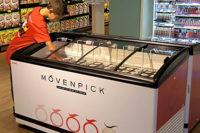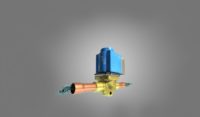Imitations of branded products from reputable, original manufacturers, otherwise known as counterfeits, exist in many of today’s consumer and industry environments. However, the negative implications of the latter can be more dangerous.
For instance, certain frozen pizzas can be tempting to purchase in what appears to be a bargain. But, if the product turns out to be of poor quality, the consumer could be disappointed and may not buy that particular frozen pizza brand again.
When buyers don’t realize the bargain is in fact a counterfeit, they are left to assume that the brand owner has supplied a poor quality product, which in turn, damages brand value and reputation.
The same can be said for the refrigerant sector, where the damage done by counterfeit products can go far beyond harm to the brand. Opting for an inauthentic refrigerant can pose serious negative consequences for the staff, equipment and environment. Despite this, there has been a rise in the volume of counterfeit products on the market.
The rise of counterfeit refrigerants
Chlorofluorocarbon (CFC) and hydrochlorofluorocarbon (HCFC) refrigerants have historically been used in refrigeration and air conditioning systems. However, when their ozone-depleting potential came to light, the Montreal Protocol was established to limit environmental impact.
The phase down of these refrigerants led to the development and introduction of a new generation of substances—the hydrofluorocarbons (HFCs). Whilst HFCs have zero ozone-depleting potential, many are perceived to have high global warming potential (GWP). That’s why the industry is now moving away from higher GWP refrigerants on a global basis with a new international agreement; the Kigali amendment to the Montreal Protocol will now see an HFC phase down in some countries from 2019. This agreement supplements measures already in place in Europe, the United States and Japan.
In the move away from higher GWP refrigerants, companies are looking to alternatives, including hydrofluorolefins (HFOs) and non-halogenated “natural” refrigerants. Although the newly developed refrigerants can have a lower direct global warming impact and zero ozone-depleting potential, they present other concerns to system operators in characteristics, cost and safety.
There have been numerous examples of fraudulent refrigerant identification across the globe. In 2013, as many as 3,500 cylinders of apparently branded refrigerant were seized in Saudi Arabia. More recently, in 2015, 900 cylinders of counterfeit refrigerant were seized in China.
Because counterfeit refrigerants are not made to the exacting specifications as the genuine branded products, they could be contaminated, diluted or even a completely different substance from what is advertised. Unlike when buying from a reputable supplier, there is no guarantee that the refrigerant will meet that specification or Air Conditioning, Heating and Refrigeration Institute (AHRI) standard 700, which details the acceptable purities and compositions of refrigerants. A refrigerant that does not match specification can negatively impact the equipment in the system and can become a health and safety hazard.
System damage and performance
The most common result of using a counterfeit refrigerant is decreased system performance. This can be because the refrigerant is not compatible with the system or because it has different characteristics to the ones expected, for example, different operating pressure. However, contaminated refrigerants can cause a range of issues, including increased energy consumption, reduced equipment operating life, system failure and even dramatic incidents such as fires and explosions, which can result in injuries or death.
Introducing a refrigerant of poor quality or of an incompatible type to the system can also lead to equipment damage, resulting in unwanted maintenance costs or downtime.
Safety
One major safety problem is that some counterfeit refrigerants have been found to contain a flammable compound—methyl chloride—which reacts with the aluminium in HVAC systems to generate reactive, toxic compounds that violently burn when exposed to air.
An example of such an incident happened in 2011, where refrigerated shipping containers exploded in Vietnam and Brazil, subsequently killing three dockworkers. This was a result of methyl chloride contamination in the refrigerant, which was used in up to 8,000 containers.
Environmental implications
Counterfeit refrigerant is often smuggled between countries and operates outside the purview of environmental and other legislation. The reported incidents of methyl chloride contamination have been associated with counterfeit R134a refrigerant. However, R134a has also been contaminated with banned refrigerants such as R22. Not only can this have legal consequences such as severe fines, but buying refrigerant containing ozone-depleting substances is also undermining regulations designed to protect the environment.
Even when the identity of the refrigerant is the same as that of the branded product, the supply of black market material also acts to undermine the environmental regulations; there is little point in having controls on what can be placed on the market by authorized suppliers when there is little or no control on the supply of under-the-counter products. If the environmental regulations are to work in the way they were envisaged, refrigerant importers need to be licensed in the same way that they were to control use of CFCs and HCFCs. Policing of refrigerant import will help ensure that the end-user can source refrigerant from reputable suppliers who abide by the rules.
Counterfeit or poor quality refrigerant can also lead to decreased system efficiency, which increases power consumption. In addition to greater running costs, the majority of a refrigeration system’s carbon footprint comes from its power consumption, and anything that acts to decrease efficiency is clearly bad news for the environment.
Detection methods
Fraudulent suppliers often plagiarize the packaging of reputable brands, which means the appearance of the packet is not enough to ensure the purchase of a genuine product. Although it’s not always possible to detect a counterfeit refrigerant from its packaging, it is possible to test a purchased product. One such refrigerant test is halide torch testing, which can be used to check for chlorinated compounds.
Equipment capable of detecting the unsafe refrigerant methyl chloride at low quantities has been available since 2012. This equipment can also be used to test for other contaminants, including CFCs and hydrocarbons. Companies should use a combination of detection methods to safeguard the system from multiple contaminants. However, AHRI does not recommend pressure testing alone as a method of counterfeit detection since a contaminant refrigerant blend could have similar pressures to the in-specification products, but still result in unsatisfactory performance.
Tackling the issue
One of the biggest challenges of tackling the counterfeit refrigerant problem is that imitation products are marketed and sold in copied packaging, meaning that an inexperienced purchaser may easily be fooled. To avoid this, buyers should work together with original refrigerant manufacturers to understand how to differentiate between reliable original refrigerants and potentially dangerous imitations.
At the end of the day, the best way that end users can be certain that they are purchasing a genuine product is to buy from a reputable supplier.



